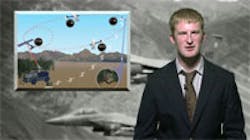NASHUA, N.H., 11 Sept. 2012. In this week's Military & Aerospace Electronics Report, Skyler Frink discusses two alternative UAV power sources.
Transcript: This is the Military & Aerospace Electronics Report, I'm Skyler Frink
Right now, UAVs are generally run using fuel or battery power. UAVs have clear limits on how long they can fly with this, but what if UAVs could be powered through alternate means?
Several companies, such as Lockheed Martin, LaserMotive and Silent Falcon UAS Technologies, have been working on different ways to power UAVs in flight. These methods of power include laser power and solar power, each with their own benefits and drawbacks.
For solar power the benefit is obvious. As long as there's sunlight the UAV can operate, and the sunlight can even charge a battery to extend the life of the UAV into the night, or keep it flying when sunlight is blocked. Silent Falcon UAS Technologies, the company behind the Silent Falcon solar powered UAV, has created a solar-powered UAV that can fly missions for up to 14 hours in daylight and six hours at night using the power of the sun.
Laser power has also shown enormous potential, with a Lockheed Martin and LaserMotive joint project showing that a Stalker UAV, a very light weight UAV used by special operations forces, can be powered for over 48 hours by outfitting it with a photovoltaic receiver and on-board power management hardware. The UAV was then powered by a ground-based laser transmitter.
With UAV power technology advancing, could we have a future where UAVs are no longer limited by the amount of fuel they can carry, or the charge of their batteries? While we still have yet to prove a UAV can stay operational indefinitely, it looks as if we may have the ability to do so sooner rather than later.
For the Military & Aerospace Electronics Report, I'm Skyler Frink
